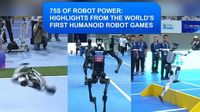The world took a bold step into the future of robotics last week as Beijing played host to the inaugural World Humanoid Robot Games, a groundbreaking event that wrapped up on Sunday, August 17, 2025. The games, the first of their kind anywhere, drew 280 teams from 16 countries to compete across 26 events, offering a vibrant showcase of the latest advances in embodied intelligence and a glimpse of how robots might soon integrate into our everyday lives.
For four days, the city buzzed with the energy of competition, collaboration, and curiosity. The stadiums were filled not with human athletes, but with robots—sleek, agile, and astonishingly lifelike—vying for supremacy in events ranging from five-a-side soccer and boxing to sprints, gymnastics, and even wushu. The games didn’t stop at athletic feats: exhibitions such as individual and group dance, as well as scenario-based events simulating real-world tasks in factories, hospitals, and hotels, pushed the robots’ abilities to their limits.
According to Xinhua, the five-a-side soccer final was one of the most anticipated events, with Tsinghua Hephaestus from China clinching the championship after a tense match against the joint team of Germany’s HTWK Robots and Nao Devils. In the three-a-side soccer showdown, the Mountain & Sea squad from China Agricultural University emerged victorious over Germany’s Sweaty. These matches were more than just a spectacle; they served as a proving ground for the robots’ advanced mobility, perception algorithms, positioning, navigation, and decision-making logic—skills with real potential for applications in daily life and professional settings.
But what was it like on the ground? The games offered a unique blend of public spectacle and technical exchange. As Xinhua described, the clash of “metal, chip and algorithm” provided a platform for global developers to witness firsthand how the integration of China’s top-tier hardware with international algorithms could solve diverse challenges. The soccer finals, for example, featured T1 robots from Beijing-based Booster Robotics, which can autonomously assess their surroundings and execute complex actions like trotting, tackling, shooting, and defending—all without human intervention. Achieving this required not only robust, lightweight hardware but also sophisticated real-time perception, advanced motion control, cognitive decision-making, and seamless multi-agent coordination.
Booster Robotics, a local powerhouse, has invested heavily in operating systems and all-in-one development tools, making it easier for users to perform secondary development and migrate algorithms across different robot brands. Zhao Weichen, the company’s vice president, explained that “robot soccer represents the most fundamental universal testing ground for technology.” He added that the modular, readable design of their robots allows developers to quickly adapt and refine their algorithms—an advantage that became evident at the 2025 RoboCup in Brazil, where German teams rapidly deployed their original robot’s algorithms onto Booster Robotics K1 robots, ultimately winning the small-size category championship.
The games also featured a dramatic boxing match between two G1 robots from Unitree. Standing about 130 centimeters tall and weighing roughly 35 kilograms, these robots donned professional boxing gloves and helmets, trading hooks, side kicks, and knee strikes with uncanny agility. Even after being knocked down, they rose unassisted to continue the fight. As Deng Huasheng from Unitree noted, “If the structure can’t withstand impacts, it will fall apart. And if the balance algorithm fails, even a slight push can topple the robot.” This event highlighted the critical interplay between hardware durability and advanced software algorithms—both essential for real-world humanoid applications.
Of course, none of this would be possible without the human talent behind the machines. One of the most striking features of the World Humanoid Robot Games was the youth and diversity of its participants. Most operators were university students and young engineers in their twenties and thirties, with some still in high school. The youngest engineer, a 14-year-old flag bearer from a Beijing junior high school, captured the spotlight during the opening ceremony. Three teams composed entirely of junior and senior high school students even competed in the soccer events, a testament to the growing appeal of STEM education and robotics among the next generation.
China’s commitment to fostering young talent in artificial intelligence and robotics is no accident. As Zhou Changjiu, president of the RoboCup Asia-Pacific Confederation and one of the event’s co-organizers, explained, “China has a culture that deeply values STEM education. Both parents and society place great emphasis on STEM, with many children actively participating in competitions, creating a unique cultural and social environment that fosters talent development.” Policy documents released in May outlined plans to establish a tiered AI education system spanning primary through high school, guiding students from foundational cognitive awareness to practical technological innovation.
The global nature of the games was unmistakable. Over ten international teams from countries like Brazil, Germany, Japan, Malaysia, Australia, Italy, Thailand, and Indonesia used Booster Robotics T1 robots in the soccer competition. According to Joao Victor, a soccer team member from Brazil’s RoboFEI, “It was the first time that I used Booster Robotics T1, and the robots were amazing.” He added that the event gave his team the chance to “talk with other teams from around the world and pick up new tactics from the competition.”
China’s prowess was further underscored at the 2025 RoboCup in Brazil this July, where two Chinese teams using Booster Robotics T1 robots swept both the champion and runner-up spots in the adult-size category. These achievements, according to Zhou, demonstrate China’s advantages across the entire humanoid robotics sector, from the industrial chain and robot hardware to a large and growing user base. The games, he said, “served as both a platform and a showcase, demonstrating to the world China’s advantages in the humanoid robotics sector from the industrial chain and robot hardware to a large user base.”
For many, the event felt like a turning point. “I’m truly excited that China is hosting the first World Humanoid Robot Games. It’s making history. A decade or two from now, we’ll look back and recognize this as the birth of the robot Olympics. Just as the Olympic Games originated in Ancient Greece, future generations will see Beijing as the birthplace of the modern robot Olympics,” Zhou declared, echoing a sentiment shared by many participants and spectators.
The World Humanoid Robot Games may have only just begun, but their impact is already being felt around the globe. By bringing together young talent, cutting-edge technology, and a spirit of international cooperation, Beijing has set the stage for a new era in robotics—one where the boundaries between science fiction and reality grow ever thinner.






